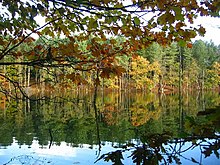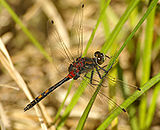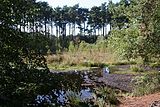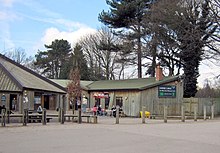Delamere Forest
| Delamere Forest Park | |
|---|---|
 Deciduous woodland at Delamere Forest in Autumn | |
Delamere Forest withinCheshire | |
| Type | Forest park |
| Location | Cheshire |
| OS grid | SJ547704 |
| Coordinates | 53°13′45″N2°40′40″W/ 53.2291°N 2.6778°W |
| Area | 972 hectares (2,400 acres) |
| Elevation | c.75–175 metres (246–574 ft)[1] |
| Operated by | Forestry England |
| Open | 8am–8pm (visitor centre)[2] |
| Parking | Six on-site car parks |
| Public transit access | Delamere railway station |
| Website | http://www.forestryengland.uk/delamere-forest |
Delamere Forestis a largewoodin the village ofDelamereinCheshire,England. The woodland, which is managed byForestry England,covers an area of 972 hectares (2,400 acres) making it the largest area of woodland in the county. It contains a mixture ofdeciduousandevergreentrees.[3]
Delamere, which means "forest of the lakes",[4]is all that remains of the greatForests of Mara and Mondremwhich covered over 60 square miles (160 km2) of this part of Cheshire. Established in the late 11th century, they were thehunting forestsof theNormanEarls of Chester.Order was maintained underforest law.However this governance limited the agricultural potential of the area for centuries. It was not until ownership passed toThe Crownin 1812 that the ancient ordinances were abolished. In 1924 the woodland came under the control of the Forestry Commission.
The area also includes Old Pale hill, the high point of the northern mass of theMid Cheshire Ridge,and Blakemere Moss, a lake around 1 kilometre (0.62 mi) in length.Black Lake,a rare example of quaking bog orschwingmoor,has been designated aSite of Special Scientific Interest(SSSI) and forms part of an internationalRamsarsite; Linmer Moss has also been designated an SSSI for itsfenlandhabitat. Thewhite-faced darter,a species ofdragonflyrare in the UK, andmarsh fernandwhite sedge,wetland plants that are rare in Cheshire, are found here.
Delamere Forest is a popular recreational area that is used by approximately 750,000 visitors each year,[5]includingwalkers,cyclists,mountain bikersandhorse riders.It is also an outdoor concert venue.
History
[edit]
Hunting forest
[edit]The twin medieval Forests of Mara and Mondrem were created within thecounty palatineof Cheshire by the Norman Earls of Chester in the late 11th century. However the area might have earlier been anAnglo-Saxonhunting forest.[6] Covering more than 60 square miles (160 km2), the forest stretched from theMerseyin the north toNantwichin the south, and from theGowyin the west to theWeaverin the east.[4][6]Between 1277 and 1536, the forests encompassed more than 60 townships or villages.[6]In this context, "forest" means an area outside the common law and subject toforest law;it does not imply that the area was entirely wooded, and the land remained largely in private ownership.[6]Game was hunted with dogs and includedwild boar,andred,fallowandroe deer.[7]During the early Norman period, the penalties for killing game were blinding, mutilation or execution; although these punishments were gradually replaced by fines.[8]
The original forest was a predominantlyoak-mixed woodland, but other species includedelm,lime,yew,chestnut,ash,silver birch,hazel,willowandalder.[9][10]The forest area also encompassedheathandwetland,as well as pasture, arable land and even small settlements.[6][11]Agriculture was, however, allowed within the forest boundaries only under severe restrictions;assarting,or enclosing and clearing new land for agriculture, was prohibited until 1215.[8][12]
As large areas of Mondrem were slowly cleared of woodland, the northerly Forest of Mara remained wooded well into the 14th century. It retained a population of wild boar andwolves.[9]

Later history
[edit]The remaining part of the southern part of the Forest of Mara remained classed as a hunting forest until 1812 when an Enclosure Act was passed disafforesting the remaining forest (that is, returning its legal status to ordinary land) and transferring ownership of the remnant half to the Crown and half to surrounding major landowners.[13][14][15]In April 1821, theKing's Benchdetermined that Delamere was one of four new parishes within the old Forest of Mara during a case about apauperfromOakmere.[16] The Forestry Commission, which was established in 1919, took over the management of Delamere Forest in 1924;[17]the land was managed for timber production.[18]Its management area occupies 16 percent of the former medieval forests.[19]Since 1968, the Forestry Commission has worked with successive local authorities (nowCheshire West and Chester) to promote recreational usage of the area.[20]
Blakemere Moss
[edit]Blakemere Moss was drained in around 1815, supposedly by prisoners from theNapoleonic Wars.During the 19th century, it was unsuccessfully planted with oak, and later withScots pine.The Forestry Commission planted the moss with pine andwestern hemlockduring the 1940s, which proved uneconomic.[21]In 1996 as part of a landscape planning exercise for Delamere Forest a hydrological survey was commissioned to look at the feasibility of clear-felling the area that is now Blakemere Moss. Once the hydrological survey confirmed that it was possible to re-water the site, clear-felling took place in 1998 and the moss was allowed to re-water by damming the drainage points. The restored moss now provides a habitat for a variety of wildlife, particularly waterfowl. Following the success of the project, it was announced in January 2010 that a further 33 hectares (82 acres) of drained fenland at four sites in the Delamere Forest area would be rewatered as part ofNatural England's "Wetland Vision" scheme.[22]
Geography and geology
[edit]
Delamere Forest forms part of theMersey Forest,an initiative to increase woodland coverage in areas close to urban communities.[3][23]Nearly all the Forestry Commission land is open access land under theCountryside and Rights of Way Act 2000.[24][25]A few small additional areas contiguous with the Forestry Commission land are also wooded.[24]
TheMid-Cheshire Railway Lineruns east–west through Delamere Forest;Delamere railway stationis located atSJ555704,around ½ mile (800 m) from the Linmere Visitor Centre. TheB5152 roadruns north–south through the forest, and Ashton Road runs east–west.[26][24]TheNational Cycle NetworkCheshire Cycleway(Regional Route 70) follows Ashton Road.[26][27]The nearest town isFrodsham,to the north-west; nearby settlements (anti-clockwise from the south) includeDelamere,Cuddington,Norley,Kingsley,MouldsworthandKelsall.[24]

Mouldsworth Gap
[edit]The majority of the modern Delamere Forest falls within the Mouldsworth Gap, a break in theMid Cheshire Ridgewhich runs north–south through the centre of Cheshire. This region originated at the end of thelast ice age,when glacial meltwaters formed a vast lake in theWest Cheshire basinwhich burst through the sandstone ridge, and deposited large amounts of sand and gravel across an extensive outwash fan on the eastern side of the ridge.[11][28]The soils are very varied, includingbrown earths,podsols,peatsandgleys.One valley adjacent to the railway line has eight different soil types within a small area, and hosts a soil trail.[29]

This part of Delamere Forest is undulating in character, with elevations predominantly in the range 60–90 metres.[24]It is composed of numerous hummocks and peatland basins, some of which are glacial in origin while others have been created by sand extraction.[22][30]The basins form lakes andmosses(bogs) within the forest, the largest of which is Blakemere Moss, which originated in two glacialkettle holesand is now a lake around 1 km in length.[26]Other sizeable wetlands includeBlack Lake,Dead Lake andLinmer Moss.[26]This forest area has several named local high points, including Hart Hill, Hunger Hill and Manley Hill.[26][24]
Old Pale
[edit]The Old Pale hill (176 metres;SJ543696) stands towards the south of the Forestry Commission-owned area; it forms the high point of the northern mass of the Mid Cheshire Ridge.[26][24]The summit, Pale Heights, has atrig pointand three transmitter masts which carry radio, television and telephone signals.[24][31]There is a view point with views of twelve counties and metropolitan boroughs:Cheshire,Cumbria,Derbyshire,Greater Manchester,Lancashire,Merseyside,ShropshireandStaffordshirein England, andConwy,Denbighshire,Flintshire,PowysandWrexhamin Wales.[26]
Ecology
[edit]
Delamere Forest encompassesbroadleavedand mixed woodlands, blocks ofconiferousplantation, as well asgrasslandandwetland.[3][11]The area provides a habitat for numerous woodland bird species, includingnuthatches,treecreepers,common crossbills,Eurasian siskins,tawny owlsandgreat spottedandgreen woodpeckers.[26][32][33]Dragonflies such as thesouthern hawkercan be seen in the wetland areas; the nationally scarcewhite-faced darterhas been observed at several sites within the forest, includingBlack Lake.[32][34][35]Butterflies such as thesmall tortoiseshellare common in the Old Pale area.[26][32]Addershave been observed in the woodland, and mammals seen here include badgers, foxes and bats.[26]
Sites of Special Scientific Interest
[edit]
TwoSites of Special Scientific Interest(SSSIs) lie within the area of Delamere Forest owned by the Forestry Commission.Black Lake(SJ537709) is an example of the rare quaking bog orschwingmoorhabitat, a type of bog in which bog vegetation forms a raft which floats on top of water. The site is particularly notable for including the very earliest stages in quaking bog development, although all stages are present, from open water to largely consolidatedschwingmoorin the process of colonisation byScots pine.In addition toSphagnumspecies,common sundewand the locally rarewhite sedgeare present. The site is managed byCheshire Wildlife Trustand forms part of the Midland Meres and MossesRamsarsite.[35][36]
Linmer Moss(SJ546706) is unusual within Delamere Forest in having afenenvironment which is not dominated bySphagnumspecies. The vegetation is predominantlytussock sedgeandreedmace.Marsh fernand white sedge, which are rare in Cheshire, are found here; other species includecuckooflower,marsh bedstraw,marsh cinquefoilandSphagnum squarrosum.The site has experienced rapid changes in water levels during its history, and contains the trunks of birch trees which died when the area flooded. It is now being colonised byalderandwillow.[37]
Multiple otherwetlandSSSIs fall within the historical bounds of Delamere Forest, includingHatch MereandFlaxmere Moss,which lie immediately outside the Forestry Commission boundary, as well asAbbotts Moss,Oak MereandPettypool Brook Valley.[38][39][40][41][42]Little Budworth CommonSSSI and the woodland around Abbotts Moss are considered to be among the closest modern representatives of the forest before human settlement in the area.[43]
Recreational uses
[edit]This section needs to beupdated.The reason given is: Linmere visitor centre is closed, the new Delamere Forest Cafe & visitor center opened in 2020.(September 2022) |

Delamere Forest is a popular recreational area, drawing visitors mainly from nearby urban areas.[20]Threelong-distance footpathsmeander through the forest, theSandstone Trail,Delamere WayandBaker Way.Two waymarked circular walking trails of 1.7 and 2.7 miles (2.7 and 4.3 km) and two waymarked cycling trails of 4 and 7 miles (6.4 and 11.3 km) start near the Linmere Visitor Centre; thecyclingtrails are also open to walkers. There are two easy-access circular trails which are suitable for wheelchair users and pushchairs; one starts at Barnsbridge Gates car park and leads to Blakemere Moss (0.75 miles (1.2 km) in length), the other explores Old Pale hill from the Linmere Visitor Centre. Numerous non-waymarked footpaths are also available for both cyclists and walkers. There is a large area of dirt cycle jumps on Manley Hill formountain bikingenthusiasts.[3][26]
Other activities includehorse riding,jogging,orienteering,bird watchingand nature study.[20][44]Britain's largestGo Apefacility opened in Delamere Forest in 2006; it includes numerous zip wires, Tarzan swings, tightropes and nets high in the treetops.[26][45]Delamere Forest is the venue for the northern Hellrunner cross-country race, and the Sandstone Trail Race finishes in the forest.[46][47]Aparkruntakes place weekly on Saturdays; the course is one loop of Blakemere Moss on the forest's trails.[48]
Since 2003, the Old Pale area of the forest has served as a music venue, playing host to performers includingIan Brown,The Charlatans,Jools Holland,Status Quo,Sugababes,Paul Weller,The Zutons,Tears for Fears,DovesandElbow.[26][49]The forest has also been used for open-air theatre.[50]

The Linmere Visitor Centre (SJ546703) has a covered picnic area, café, toilets (including disabled), and a cycle hire facility and shop.[51][52]Picnic facilities are also found at numerous points within the forest including most parking areas, and refreshments are available at weekends at the Barnsbridge and Whitefield car parks during the peak season.[53]A classroom and "learning garden" near the visitor centre can be hired for educational visits.[51][54]
See also
[edit]References
[edit]- ^Northwich & Delamere Forest(Map). 1:25000. Explorer Series. Ordnance Survey.
- ^"Delamere Forest".
- ^abcdForestry Commission: Delamere Forest Park: InformationArchived16 April 2018 at theWayback Machine(accessed 4 May 2010)
- ^abBevan, p. 4
- ^"Delamere redevelopment project".Forestry England.Retrieved10 February2021.
- ^abcdeHusain, pp. 54–59
- ^Husain, p. 68
- ^abHusain, pp. 62–63
- ^abPhillips & Phillips, p. 34
- ^Bevan, p. 13
- ^abcVale Royal Borough Council: Supplementary Planning Document 5 (September 2007) (downloaded from"Supplementary Planning Documents".Archived fromthe originalon 1 May 2010.Retrieved9 May2010.;4 May 2010)
- ^Husain, p. 72
- ^Husain, p. 64
- ^Bevan, p. 18
- ^Coxhead & Bevan, p. x
- ^Barnewall, Richard Vaughan, Sir Edward Hall Alderson, William Selwyn (1822).Reports of cases argued and determined in the Court of King's Bench: with tables of the names of the cases and the principal matters, Volume 5.J. Butterworth and son. pp.775–777.
{{cite book}}:CS1 maint: multiple names: authors list (link) - ^Forestry Commission: History of the Forestry Commission(accessed 6 May 2010)
- ^Tigwell, pp. 45–46
- ^Natural England: Shropshire, Cheshire and Staffordshire Plain/Cheshire Sandstone Ridge(accessed 6 May 2010)
- ^abcTigwell, p. 138
- ^"The ditches were coated with ice. Between them the peat quaked beneath our feet. I felt I had stumbled into Conan Doyle's lost world".The Independent.25 January 1997.Retrieved5 May2010.
- ^ab"Wildlife Extra: Cheshire's ancient peatland to be restored".wildlifeextra.com.January 2010.Retrieved5 May2010.
- ^The Mersey Forest: Overview(accessed 8 May 2010)
- ^abcdefghOrdnance Survey: Explorer map 267: Northwich & Delamere Forest: Winsford & Middlewich
- ^Natural England: CRoW Access Land Maps: Delamere Forest (downloaded from[1];5 May 2010)
- ^abcdefghijklmDelamere Forest Park Guide (Forestry Commission leaflet)
- ^Sustrans: Map: Delamere Forest(accessed 5 May 2010)
- ^Husain, pp. 59–61
- ^Burek, Cynthia (2005)."England's first soil trail"(PDF).Earth Heritage.24:12.Retrieved5 January2016.
- ^English Nature: Meres and Mosses (27 February 1998)
- ^Bevan, p. 80
- ^abcForestry Commission: Delamere(accessed 5 May 2010)
- ^Forestry Commission: Wildlife rangers uncover love nest at Delamere Forest (8 May 2007)(accessed 5 May 2010)
- ^Cheshire region Biodiversity Partnership: White-faced Darter (Leucorrhinia dubia)Archived16 July 2011 at theWayback Machine(accessed 5 May 2010)
- ^abNatural England: Black Lake, DelamereArchived23 October 2012 at theWayback Machine(accessed 5 May 2010)
- ^Cheshire Wildlife Trust: Black LakeArchived19 April 2010 at theWayback Machine(accessed 8 May 2010)
- ^Natural England: Linmer MossArchived23 October 2012 at theWayback Machine(accessed 5 May 2010)
- ^Natural England: Hatch MereArchived23 October 2012 at theWayback Machine(accessed 4 May 2010)
- ^Natural England: Flaxmere MossArchived23 October 2012 at theWayback Machine(accessed 5 May 2010)
- ^Natural England: Abbots MossArchived29 July 2012 at theWayback Machine(accessed 8 May 2010)
- ^Natural England: Oak MereArchived23 October 2012 at theWayback Machine(accessed 8 May 2010)
- ^Natural England: Pettypool Brook ValleyArchived23 October 2012 at theWayback Machine(accessed 10 May 2010)
- ^Local History Group & Latham (ed), p. 12
- ^Forestry Commission: Delamere Forest Park(accessed 5 May 2010)
- ^Go Ape! at Delamere,Go Ape!, archived fromthe originalon 13 December 2007,retrieved30 March2008
- ^PUMA HellRunner: Hell Up North(accessed 5 May 2010)
- ^Deeside Orienteering Club: The Sandstone Trail Race(accessed 5 May 2010)
- ^"Delamere parkrun - Weekly Free 5 km Timed Run".parkrun.Retrieved27 July2018.
- ^Forestry Commission: A Brief History of Forestry Commission Live MusicArchived18 June 2016 at theWayback Machine(accessed 4 May 2010)
- ^Forestry Commission:A Midsummer Night's Dreamat Cheshire's Delamere Forest (7 July 2008)(accessed 8 May 2010)
- ^abForestry Commission: Linmere Information Centre(accessed 5 May 2010)
- ^Forestry Commission: Cycling(accessed 5 May 2010)
- ^Forestry Commission: Car Parks(accessed 5 May 2010)
- ^Forestry Commission: Learning Opportunities(accessed 5 May 2010)
Sources
[edit]- Bevan RM.Tales of Old Delamere Forest(CC Publishing; 2005) (ISBN0-949001-24-4)
- Coxhead AD, Bevan RM.The Story of Delamere House and Delamere Park(CC Publishing; 2008) (ISBN978-0-949001-37-5)
- Husain BMC.Cheshire under the Norman Earls: 1066–1237.A History of CheshireVol. 4 (JJ Bagley, ed.) (Cheshire Community Council; 1973)
- Local History Group, Latham FA (ed).Vale Royal(The Local History Group; 1993) (ISBN0 9522284 08)
- Phillips ADM, Phillips CB (eds).A New Historical Atlas of Cheshire(Cheshire County Council & Cheshire Community Council Publications Trust; 2002) (ISBN0-904532-46-1)
- Tigwell, Rosalind E.Cheshire in the Twentieth Century.A History of CheshireVol. 12 (JJ Bagley, ed.) (Cheshire Community Council; 1985) (ISBN0-903119-15-3)
External links
[edit]- Discovercheshire website (Delamere Forest Park page)
- Delamere Loop cycle and horse riding route (Discovercheshire website)
- Information and photographs on Delamere Forest from the Cheshire Now website
- Tourist and Visitor Information covering the local area surrounding Delamere Forest
- Visitor Guide to Mountain Biking in Delamere Forest

